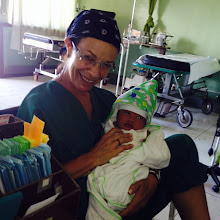Brown Recluse Spider or Violin Spider
In South Africa, there are a few 8 legged creatures which have the ability to cause massive tissue destruction. Since I am not a creepy crawly specialist and usually only get to see patients when the toxic venom has already caused significant damage, I'd refer you to other sites for detailed info on specific spiders. Here, I'd like to share one case of what we believe was probably a Brown Recluse Spider bite.
The venom of the Brown Recluse Spider, also know as the Violin spider, is believed to be more toxic than the venom of a Rattle snake. Because so little of the venom is injected, it causes less tissue damage (cyto toxic). Patients frequently report not feeling the spider bite until about 2-4 hours after the bite. Symptoms include severe pain at the site of the bite, fever, burning, itching, nausea, abdominal cramping, Headache, muscle pain. The puncture wounds may or may not be visible shortly after being bitten, these will often heal in 2-3 days.
The surrounding tissue will become hard with increased pain, frequently with a inflamed red and blue disclouration. Blistering usually is the first visible stage of tissue breakdown. This may progress to massive tissue destruction. By day 3, the skin and subcutaneous tissue has broken down, presenting with an open wound and visible dead tissue. Victims are frequently taken to theatre for repeated surgical removal of necrotic tissue, thus enlarging the wound. Once all the necrotic tissue has been surgically removed and the wound bed is sufficiently prepared, most frequently using Negative Pressure dressings, skin grafting is done to close the defect. Antibiotics play an essential role of managing spider bites.
The surrounding tissue will become hard with increased pain, frequently with a inflamed red and blue disclouration. Blistering usually is the first visible stage of tissue breakdown. This may progress to massive tissue destruction. By day 3, the skin and subcutaneous tissue has broken down, presenting with an open wound and visible dead tissue. Victims are frequently taken to theatre for repeated surgical removal of necrotic tissue, thus enlarging the wound. Once all the necrotic tissue has been surgically removed and the wound bed is sufficiently prepared, most frequently using Negative Pressure dressings, skin grafting is done to close the defect. Antibiotics play an essential role of managing spider bites.
Case Study 1
This 30 year old, non insulin dependent diabetic man was bare foot and cleaning out a store room packed with old furniture and old newspapers. About three hours after he started cleaning out the store room, the patient began feeling ill. He first experienced abdominal cramps and began perspiring. Shortly after that his foot began to burn and swell, followed by nausea and fever. This patient only sought medical advice the following day when his foot became severly swollen and painful. He was admitted to a rural hospital where he was managed for 3 weeks before the he was referred for assistance.
The first photo was taken 21 June 2007....
Wound bed preparation was initiated immediatley with copious Chlorhexadine washes followed by Silver Sulpherdiazine daily for 6 days. This was followed by Negative Pressure dressings starting on 27 June 2007.
This next picture was taken on 9 July 2007 after 12 days of negative pressure therapy.
On 8 August 2007, the wound was ready for a skin graft.
Day 6 after skin graft, 14 August 2007.
Day 10 after skin grafting, 18 August 2007.
5 September 2007, patient was discharged with Class II compression stockings over light dressings.
Healing in this patient was a little slower than expected due to underlying diabetes, poor initial management of the wound and lastly, poor patient co-operation.
Probably one of the most important things to remember about wounds on legs.........ALWAYS , ALWAYS, ALWAYS keep the leg elevated to the same height as your hip. Legs swell easily, especially when they are injured. Swelling reduced the oxygen and nutrient rich blood to the wounded area and this causes slow healing.
Keep it UP!







Please could you help? I was bitten by a violin spider 3 days ago on the side of my foot, and am panicking after reading some of your cases results from bites from the same spider.
ReplyDeletemy doc has me on antibiotics and mybulen.
I would like to know how to prevent it advancing into those awful craters that eventually need grafts?
I am so concerned as I went to work today and with all my walking etc. it swelled up quite a bit.
Any advise would be so appreciated.
Hi Belinda. Sorry to hear about your spider bite. Not sure where you are located or what resources you have access to?
ReplyDeleteAnolyte should be used on all wounds involving toxins.
Elevating to hip height to alleviate swelling is important but more importantly, you should rest the foot completely. Your GP may prescribe some medication to prevent blood clots depending on your risk of developing a deep vein thrombosis which may be increased during longer periods of rest.
Keeping the wound clean using a broad spectrum antimicrobial is important as is removing dead tissue surgically. Containing the toxic effects of the spider bite is possibly a bit late since you say you ran around all day and your foot is swollen. The toxin has very likely already spread. The degree of necrosis the toxin may cause varies on a multitude of factors, you may be fortunate to have limited damage. Any blacken or very red areas should be monitored and changes reported to your doctor or contact me. Always keep wound covered with appropriate dressing and change twice daily if the wound is deteriorating or daily if it is slowly healing.
If you'd like to email me some pictures and a background history on your general health and list of medication, I'd be happy to reply. Email the pic to liz@wounds.co.za